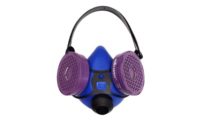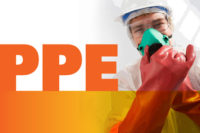For many of us, there’s nothing more anticipated in the morning than a freshly brewed cup of coffee. What makes the aroma so enticing? According to the Coffee Research Institute, the smell is due to more than 800 aromatic compounds – one of which is styrene, which occurs naturally in some plants and foods, such as coffee beans.1
While the small amount of styrene in coffee is generally considered harmless, workers exposed to styrene as part of their job may not be as fortunate.2 Alterations in vision, hearing loss and longer reaction times have been associated with styrene exposure in the workplace. Styrene vapor is also irritating to the eyes and respiratory tract.3 Many workers are exposed to styrene during the manufacture of plastics, synthetic rubber, resins and insulators.
Respiratory protection is among the safeguards required to help protect employees from organic vapors, such as styrene and toluene. OSHA standard 29 CFR 1910.134 provides key guidance for developing and implementing a respirator program when harmful vapors are present.
OSHA’s methods
One of the challenges safety managers and industrial hygienists run into with respiratory protection is the proper change-out of respirator cartridges. The OSHA standard allows two methods for determining cartridge change-outs: developing a cartridge change-out schedule, or using cartridges with an end-of-service-life indicator (ESLI).
The idea of using cartridges with an ESLI is new to many safety managers and industrial hygienists because no ESLI option previously existed for broad spectrum organic-vapor exposure. Those who work with organic vapors have had only one option: change-out schedules.
But that’s no longer the case in many situations. An ESLI is now available for use with certain organic vapors above certain concentration thresholds. Now that employers have a choice, it’s worth examining the pros and cons of each change-out method to determine the one that best matches needs in your workplace.
Change-out schedule
In instances where an ESLI is not available or appropriate for a workplace’s conditions, OSHA requires that employers develop and implement a change-out schedule for respirator cartridges.
The change-out schedule must be based on objective information to ensure cartridges are replaced before the end of their service lives. Such information includes “the exposure assessment and information based on breakthrough test data, mathematically based estimates and/or reliable use recommendations from the employer's respirator and/or chemical suppliers.”
The collected information can be used to create a change-out schedule through multiple methods. On its website, OSHA outlines three options for estimating a cartridge's service life: conducting experimental tests, using a manufacturer’s recommendation, and using a math model.4 Some respirator manufacturers offer free online service-life calculators, which can help produce cartridge service-life estimates in minutes via math models.
Pros: A change-out schedule is the go-to and standard-compliant method when an ESLI cannot be used. This is especially applicable in instances where exposure levels may be too low that they don’t register on the ESLI.
A change-out schedule can also give employers a more concrete sense of what their cartridge requirements will be for the long term. Knowing that eight workers will replace their cartridges on a weekly basis, for example, can help a safety manager or industrial hygienist understand stocking and purchasing activities across a set period of time, and thus budget accordingly. Plus, change-out schedules have been done for years and industrial hygienists are comfortable with how to administer them.
Cons: The biggest downside of using a change-out schedule comes in trying to apply a one-size-fits-all approach across a range of workers, all of whom have variations in how they do their jobs. Each worker will have a different exposure level based on the unique job characteristics. This can include variations in breathing rates, exposure time and work practices.
As a result, a single change-out schedule may not fully align with each individual worker. This could result in workers using a respirator cartridge beyond its actual service life, which can lead to potential exposure and safety issues, as well as potential costs in the form of OSHA fines or workers’ compensation. It can also lead to workers changing their cartridges before they reach the end of their service lives, resulting in higher equipment costs.
Additionally, cartridge service life will change as factors such as work practices, contaminant levels, temperature and humidity change. As a result, even the most thorough exposure assessments become obsolete as operations evolve or as weather shifts from season to season.
The ESLI option
Cartridges with an ESLI are now available for use with a wide range of commonly used organic vapors, including toluene, styrene, MEK and xylene.
This ESLI includes an indicator bar located on the organic vapor cartridge that workers can use to monitor their cartridge’s service life. The ESLI absorbs organic vapors as they enter the cartridge, which in appropriate environments with the specified vapors above certain concentrations results in visible growth of the indicator bar. The ESLI’s performance is not affected by other types of gases or vapors, or by humidity or temperature changes in most workplaces.
In appropriate environments, each individual user knows it’s time to change the cartridge when the indicator bar reaches the end-of-service line.
Pros: The greatest benefit an ESLI can deliver is helping employers optimize cartridge change-out schedules. Whereas a set change-out schedule typically cannot be customized to the varying job functions and working conditions of each employee, an ESLI provides the means to adjust cartridge change-outs down to the individual level.
This can also help simplify change-out enforcement. Rather than marking cartridges with replace-by dates or regularly checking to ensure workers have changed their cartridges, safety professionals can do quick visual inspections to ensure proper change-outs are being conducted.
Cons: This ESLI cannot be used as a primary method for determining cartridge change-out in every situation. It can only be used as the primary method for certain organic vapors and exposure levels. Safety professionals must always conduct an exposure assessment and review the cartridge user instructions before relying on this ESLI as the primary method for determining cartridge change.
By design, ESLIs have a built-in safety margin of at least 10 percent remaining service life. In use, there will typically be even more remaining service life when cartridge change is indicated. The ESLI technology also comes at an additional upfront cost.
It’s personal
An ESLI isn’t a fit for every workplace. Sometimes it may work better as a backup method for determining cartridge change-out, such as in places where organic vapors are normally at low exposure levels, but may occasionally spike above normal levels.
In situations where this ESLI can be used, it can give workers greater confidence in their equipment and their own personal safety. More than that, optimizing cartridge change-out schedules to each individual user can help potentially reduce health and safety risks.
References
1 Coffee Research Institute, Coffee Chemistry: Coffee Aroma, http://www.coffeeresearch.org/science/aromamain.htm
2 U.S. Public Health Service Agency for Toxic Substances and Disease Registry, “Toxicological Profile for Styrene,” pp. 5, 68-72, 89-90, November 2010, http://www.atsdr.cdc.gov/ToxProfiles/tp53.pdf
3 Environmental Protection Agency, OPPT Chemical Fact Sheets, Styrene Support Document, December 1994, http://www.epa.gov/chemfact/styre-sd.pdf
4 U.S. OSHA, Change Schedule Requirements, https://www.osha.gov/SLTC/etools/respiratory/change_schedule.html



